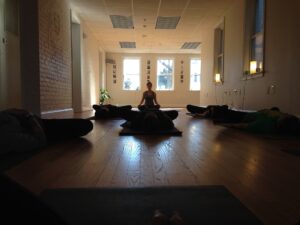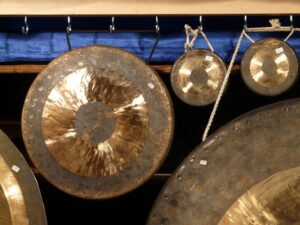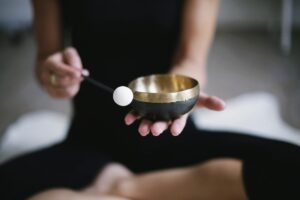
An Insider Connection – Sound Baths
There’s a guy who works with us at nersdy. He’s a sound designer by training (Master of Fine Arts in Sound Design) and by experience. Not a sound engineer. A sound designer, you know, the creative side of using sound. The other day he said he was headed to The Gong Shop in San Francisco. What? Wait a minute! What’s a gong shop. Well, he works at one of these posh weekender retreat places as a Naturalist, taking people on nature hikes in the woods and along the beach. The place has all sorts of health building and relaxing therapies going on and the management asked him if his sound design expertise could help them with their Sound Bath program. So, he’s buying new gongs, handmade by craftsmen in China, to create new sounds for the program. When something improves health and promotes relaxation, we can’t ignore it.
Welcome to the Neuroscience Research and Development Consultancy website. Have a question or a comment? Send it to us at: Comment@NeuroSciRandD.com
The Sound Bath Immersion for Your Body and Soul
For many people a water bath in a bathtub can be relaxing. Slide into a tub of nice warm water, not too hot, and the cares of the world can melt away. Immersion in an atmosphere of specifically-designed sound can do the same thing, or even do it better, and you don’t have to get wet. It’s quite a bit like good music, but not dance music or ballads. It’s sounds you both hear and feel. A quality sound bath uses sounds with felt vibration frequencies. At first you’re just relaxing in a room and you start to hear a variety of sounds and noises, but within a few moments you slip into the embrace of sounds so resonant you feel it almost more than you hear it. Boom, you’re gone. It’s sort of like meditation but without any effort. Unlike yoga or exercise, there’s no physical work to be done.
A Reader Asks:
How can you recommend sound baths? I tried one and it made me feel dizzy and a little nauseated.
Sound baths are a specific and personal experience. While most people find them remarkably relaxing, it’s not a good experience for everyone. They are immersive. There are a few individuals who don’t do well with immersive experiences. The environment unsettles them. Sound baths can be energizing, which some people experience as anxiety. As with the various forms of meditation, as a person relaxes, emotions can well up, leaving one joyful or sad and tearful. Whether it’s a roller coaster ride or sleeping in a pup tent on a camping trip, people tend to continue to pursue what feels good and avoid what causes discomfort. And that’s the way it should be.

The Process of a Sound Bath
The first task of the sound bath guide is to set up a comfortable location and help each person assume a comfortable and relaxed position, often lying on a yoga mat with a pillow under their head and, if the person wants, a blanket. A typical configuration is to have people arranged in a semicircle with their heads pointed toward the source of the sounds. The arrangement, of course, needs to vary depending on the size and shape of the room and the number of participants. Then the sounds are started and people are left to enjoy it. The sound is created by various musical instruments noted for making vibrational sounds that one can feel. Examples are gongs, bell-like instruments called “singing bowls”, bells, Tibetan chimes called “tingshas”, and other vibrational instruments. At the end some people need to be gently reoriented to their surroundings.
Sound Baths and Well-Being
The intent of experiencing a sound bath is to promote emotional and even spiritual well-being. “Spiritual” in the sense of the search for meaning and purpose in life. A perhaps hoped for secondary benefit, to the extent that emotional well-being supports better physical health, is improved bodily well-being, too. Building on this concept, some people consider sound baths as curative in some way, calling them sound healing, or sound therapy, or even vibrational medicine. Typically sound baths last about 45 minutes, but sometimes as long as an hour. There are individuals who prefer to enjoy them on a schedule, like maybe a sound bath every other week.

Sound Baths Are Different Than Meditation
There are many sorts of meditation that people enjoy, like mindfulness, Zen, mantra, or Transcendental meditation. There are actually many others. A complete list would be too long for this discussion. Meditation presents a dilemma, however, in that one needs to learn it, practice it, and finally gradually get better at it. The benefits of relaxation come with time, practice, and patience. Not all of us are patient people, and many of us don’t want to spend a lot of time learning something new. It’s almost as though, if you’re willing to do meditation, you don’t need to meditate. You’ve already got the needed mellow personality that can make it work for you. There’s no learning curve to sound baths. Just sit back and listen to the music. It works the first time, no training needed.
So, Sound Baths Are Just Music Therapy
No, not true. Music therapy is different. Music therapy is just music. We all like listening to the music we like and don’t want to hear music we don’t like. So music therapy requires a matching of the person and the music. Music therapy also depends a lot on the expertise of the musician. While it’s true that sound baths might be more finely tuned when given by a trained and experienced practitioner, years of training are not a necessary component for learning to play the gongs, “singing bowls”, and other sound bath instruments in a way that provides the central effect of immersion and relaxation.

Sound Bath Information on the Internet: Pay Attention to Quality
A final word of caution. Sound baths are a helpful, healthy way to relax. Our intent here at nerdsy (NRDC, the Neuroscience Research and Development Consultancy, LLC) is not to promote mysticism, magic, or religion, but solid pathways to better health. As with every topic, there’s a lot of poor quality information about sound baths floating around on the Internet. For example, today’s sound baths are for us today, and are a recent addition to the art and science of health and relaxation. The typical sound bath, as it’s done today, did not originate 40,000 years ago, or 2500 years ago, or 900 years ago. True, some of the musical instruments have been around for a couple of millennia, but today’s version of sound baths have been around for about twenty years.
Helpful links:
Sound healing information from Dr. Tamara Goldsby, a Clinical Research Psychologist in Integrative Medicine at the University of California, San Diego.
Effects of Singing Bowl Sound Meditation on Mood, Tension, and Well-being: An Observational Study by Tamara Goldsby PhD
Sound Healing: Mood, Emotional, and Spiritual Well-Being Interrelationships by Tamara Goldsby PhD
